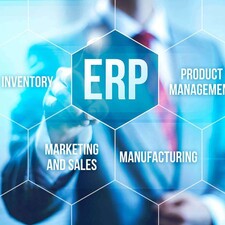Blog
How Defining the Right ERP KPIs Can Drive Productivity and Profitability

Summary
An Interview with ERP KPIs Expert Paul Hemmings, Part 1
What key performance indicators (KPIs) help today’s top manufacturing companies drive improvement and growth in all aspects of their operations? The answer depends upon the particular needs of each company and their industry, but having the right ERP KPIs and using them to make adjustments (course corrections) along the way is exactly what KPIs are all about. While commonly-used KPIs around revenue generation and customer satisfaction might seem valuable, they typically fail to provide manufacturers with specific, actionable insights about what adjustments to make when things go wrong.
In order to better understand how manufacturers can define the best ERP KPIs for their needs, KPIs that align with their key strategic goals and offer insights in real time about what operational/business changes might be needed, abas USA spoke with Paul Hemmings, an abas USA Special Projects Manager who helped write The KPI Playbook for Modern Manufacturers.

Interested in reading the full playbook and accessing the KPI formulas? Download the KPI Playbook for Modern Manufacturers here.
The Playbook offers 16 different ERP KPIs, which focus on manufacturing/production, inventory, and quality/QC. In this first post of two, we’ll focus on the intent of the Playbook and its manufacturing KPIs. In the second post, we’ll explore KPIs related to inventory and quality.
About the KPI Playbook
Hemmings explains that the goal of The KPI Playbook is to broaden the scope of KPIs so they more closely align with strategic objectives. “The KPIs most businesses focus on tend to be narrowly-drawn and are monitored and shared within the top leadership group only.”
Having the wrong KPIs is like having a car, and all you do is see how fast it goes.
The problem with these KPIs is that they don’t actually help manufacturers make real-time decisions in a precise way. Hemmings likens having the wrong KPIs “to having a car and all you do is see how fast it goes. But ultimately, some part of the car is going to break down. If you don’t look at all the different factors related to maintenance, fuel consumption, and all the ‘under the hood’ stuff, you’re not seeing the total picture. When the car does ultimately break down, you could have prevented it if you’d monitored the components that help it to go fast.”
Having visibility “under the hood” of your business can keep you running smoothly, so you won’t be broken down at the side of the road scratching your head.

The Right ERP KPIs for You
It all starts with understanding your business and your strategic objectives, notes Hemmings: “Begin by asking ‘which KPIs are relevant to my particular business and industry?’ Your KPIs must be aligned with your company’s strategy and objectives. If you get the right KPIs, then corporate performance will improve. If you get the wrong ones, you’re spinning your wheels with irrelevant indicators.” So work backwards from your strategic goals to find the actions that move the needle on those strategic goals.
How ERP Solutions Integrate Your KPIs
A key to leveraging ERP KPIs is having real-time visibility into your KPIs. “It’s important to make sound business decisions based on real-time, relevant data,” explains Hemmings. “If you have the right ERP software, you can track your KPIs through detailed data analysis using one central database that’s constantly capturing information and data across your whole company.” Your ERP system thus compares to a cockpit on a plane: you can see what’s happening with all your systems and operations in real-time, and make necessary adjustments. With an ERP system, says Hemmings, “you have a dashboard, displays, graphs, as well as reports” that offer you actionable insights to base decisions upon.

Production KPIs
Nine of the 16 KPIs in the Playbook relate to manufacturing/production, and, as Hemmings emphasizes, all 16 ERP KPIs are interconnected. Let’s explore some of these production KPIs.
- On-Time Delivery. For manufacturers, on-time delivery is clearly a big deal. When you don’t deliver quality on time and on a consistent basis, you lose customers and money. “The goal is to have the right product in the right quantity available at the right time. But that definition is based on the business you’re in and your customers’ expectations,” says Hemmings.
- Rate of Productivity. The more productive you are, and the less downtime you have, the better. But you need to base your production goals on a precise, realistic understanding of your capabilities and needs, notes Hemmings. “You have to measure and set realistic rates, utilizations and efficiencies.”
When problems arise that impact productivity, your ERP system can alert you and also help uncover the causes, enabling you to quickly develop an action plan. “Are you seeing machine breakdowns, capacity bottlenecks, manufacturing defects stopping the line, bad material from your vendors or perhaps poorly trained personnel? All of these factors will affect productivity. Your ERP system can help you Identify challenges and trends through your data, helping you determine what remedial process needs to happen,” says Hemmings.
- Manufacturing Capacity Utilization (MCU). How can manufacturers plan their production in an optimal way? The key, again, is having realistic targets and visibility into your processes, so you can resolve production problems as they arise. “If a company wants to make sure they’re achieving their maximum throughput efficiency,” says Hemmings, “they should invest in advanced planning and scheduling (APS) software, which is available as part of the abas software system. It gives you graphic visibility into all aspects of your business and key resource data, including materials, machine capacity, personnel capacity and availability, potential bottlenecks, sales orders, purchase orders, material availability, and more. You’ll know the potential points in your business processes that could cause delays or inefficiencies.”
APS also allows you to build in contingency planning for when unanticipated events occur.
“The ‘What If’ functionality of APS helps optimize your complete business operations,” explains Hemmings. “So maybe a key vendor is not able to provide parts on time, maybe a machine breaks down. Planning and Scheduling will give you options when a contingency actually occurs: you can issue a revised plan to remedy or minimize disruption and downtime.”
- The Takeaway: Define the right KPIs for your business that align with your strategic goals. Then gain real-time visibility into those KPIs through an ERP system that enables actionable insights and facilitates data-driven decision-making.
For more information on defining, monitoring and leveraging KPIs, download The KPI Playbook for Modern Manufacturers


